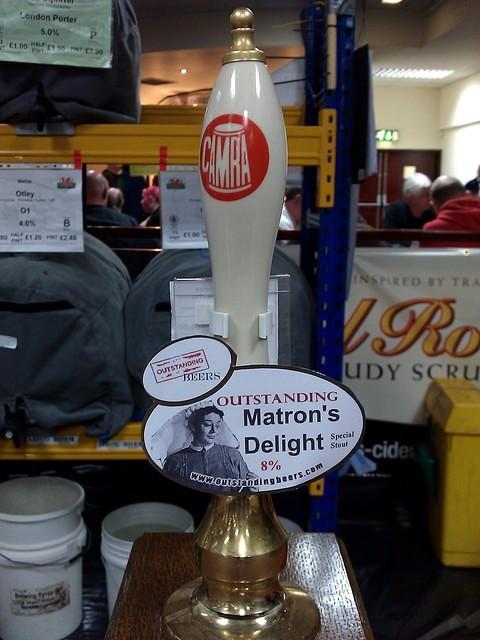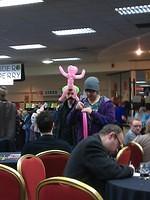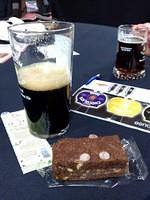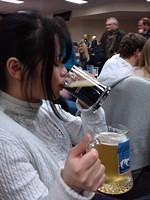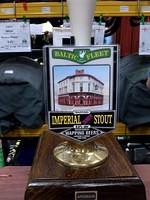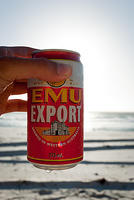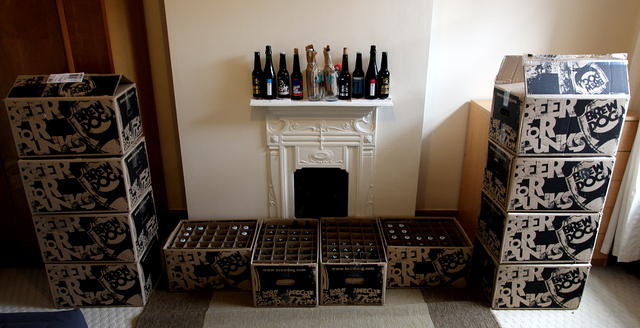After years of wanting to visit the National Winter Ales Festival (NWAF) we’ve finally done it. Out visit was a little extravagant: travelling to Manchester and staying for 3 nights – just for a beer festival! Of course we intended to have a bit of a tourist around Manchester as well, the trip was motivated by beer but not quite entirely taken up by the malt nectar. While in Manchester we visited the ale festival thrice: Wednesday and Thursday evenings and Friday afternoon.
Wednesday
On Wednesday we arrived in Manchester at about 14:00 and headed to our hotel to settle in. Rather than head straight to the festival we wandered around the city a bit first. Walking down to the river and back, picking up a few groceries (self-catering hotel/apartment) and having an espresso or two along the way. Eventually we headed for the Oldham Street bus stop and after a short trip arrived at the NWAF at around 18:30.
Our focus on Wednesday was the “Championship Bar”. This bar housed the candidate beers for the “Champion Winter Beer of Britain”. Judged during the trade session on Wednesday afternoon the winner was Hop Back “Entire Stout” (4.5%), silver went to Marble “Chocolate” (5.5%), and bronze to Dow Bridge “Pretorian Porter” (5% – no decent link). We tried all of these, of course, and Marble’s Chocolate was my favourite of the three. The Championship Bar’s stock included Thornbridge “St. Petersburg Russian Imperial Stout” – a seriously big beer, probably my favourite beer of those I tried from the championship set. I do like my imperials!
A notable non-championship beer enjoyed on Wednesday was Fuller’s “Brewer’s Reserve No.2” (7.7%). There was a Fuller’s “Brewer’s Reserve” at the GBBF which I didn’t rate very highly, though queuing for 5 minutes to get a ⅓ probably didn’t help. However, the “Reserve” at the NWAF was excellent. Super-smooth & tasty. Certainly one of the best non-imperial-stout cask ales I’ve had that’s north of the 7% mark. Most cask ales this strong aren’t the stouts I prefer but usually “barley wines” and these have a bad tendency to taste a bit off to me. The Brewer’s Reserve No.2 had none of the nasty flavours (overripe banana, alcohol, nail-polish remover, etc) and all of the right flavours (rich, spice, wood, vanilla, light chocolate). Quite tempted to buy a bottle! This is a beer that makes me consider trying more from the “barley wine” list. I went on to try the Strands “Barley Wine” (9.5%) and while enjoyable this ended my barley-wine exploration. My notes on this beer at the time were “Like BrewDog Devine Rebel but less hops”.
The worst beer I tried from the championship selection was the Isle of Sky “Black Cuilin” (4.5%). A pity as I’d heard good things about this brewery. Unfortunately this beer was all rotten banana to me and I had most of my half tossed into a slops bucket.
I made specific notes about three other beers on the night. Regarding Kat’s Boggart “Dark Rum Porter” (4.6%) I tweeted: “really “Baileys Porter”? Very “girly” for a porter. Kat: “chocolate milkbottle candy””. Another one of Kat’s was Robinson’s “Ginger Tom” (4.3%) on which my note was: “ginger beer as it should be. Sweet maybe, but most “ginger beer” lolli-pop is far too sweet.” (That said, the day after we tried Marble “Ginger” at the Marble Arch and found this to be a much better ginger-ale. It was less sweet & more beery, less like a softdrink.) On my final beer of the night, Black Isle “Hibernator” (7%), I merely said “pudding” (but as the last beer of a night at a beer festival that’s not an entirely reliable assessment!)
Thursday
We decided not to get to the festival until about 19:00, giving us time to digest the beer we’d had at The Old Wellington and The Marble Arch during the afternoon (that’s another story). To keep some focus I had two strains of beer tasting to work through on this day: wheat beers and imperial Russian/Baltic/etc stouts (IRS). This pairs the list of beers down to a manageable (if somewhat high ABV) list.
To wet my palate for the evening I picked up a quick half of the Bernard “Cerne Pivo” (5.1% – unfiltered dark pilsner, if I recall correctly). To be honest this was quite disappointing. I believe I had this at the GBBF and my memory of it was a lot better than this fresh experience. So, on to an imperial. I started with a repeat of the excellent Thornbridge “St. Petersburg” (7.7%), ’nuff said. I followed this with another imperial, the Liverpool Organic “Imperial Russian Stout” (8.9%). I’ve made no notes about this but recall not being particularly excited by it.
I moved on to a sequence of three wheat beers, the only ones easily identifiable as such from the beer list. The first was Little Valley “Hebden Cloudy Wheat” (4.5%) the second Otley “O Garden” (4.8%), and the last Outstanding “White” (5%). The “O Garden” was very tangerine, orange-peel and rindy bitterness, “almost, but not entirely, completely unlike Hoegaarten” I wrote at the time. The “White” was drier but a bit flat in flavour, very little aroma (much more like Hoegaarten!) The “Hebden Cloudy Wheat” was the winner of the trio, with a great balance of lemon juice and spice with a hint of orange rind.
Wheat beers are all very well, but on the night the winner for me was Outstanding “Matron’s Delight” (8%) imperial stout. Making up for their rather dull wheat beer the “Matron’s Delight” was an excellent smooth, full bodied, and tasty example of the IRS species. I had a couple more un-notable beers after this then finished off the evening with another excellent 3rd of the “Matron’s Delight”.
We also ate at the festival on Thursday. I complained bitterly about the food at the time, and in reflection I stand by my complaints. Beer festivals are about good beer with good flavour, the flavour range and complexity available at a winter ale festival is particularly wide and varied. Great beer deserves to sit alongside great food. In general the quality of food at beer festivals needs to move up a few notches. I really expected better from the “National Winter Ale Festival” than piled-high plates of average rice, curry, baked potatoes, and chips. Even a just a selection of quality cold pies and cheeses would be a 100-fold improvement.</whinge>
Friday
Our final beer festival jaunt. We decided to do an afternoon stint this time since it was Friday and given how busy Thursday night was we expected Friday night would be heaving. Good thing too, on Friday afternoon the festival was packed – busier at 14:00 than on either Wednesday or Thursday evenings.
I boldly launched straight into an Allgates “Mad Monk” (7.1%), a legendary imperial Russian stout. As good as I remembered it and a great, if strong, start to our 3rd trip to the NWAF. My next beer was a bit of a downer, another beer tipped in the slop bucked that was made by a brewery I’ve been hearing good things about. This was the Dent “T’Owd Tup” (6%) and my only note about it was “smells a bit like sick”.
I’d planned to do a side-by-side tasting of two interesting looking beers on this day. However, I was foiled by them obviously being so good that they had been drunk dry! Breweries here have been doing interesting things lately with strong and hoppy IPAs and I had my sights set on the Amber Ales “Imperial IPA” (6.5%) and the Hydes “Hydes IPA” (6%) – alas it was not to be. However while looking for the Hydes I noticed that the Greenfield “Monkey Business” (4.4%) was a cloudy wheat beer (it was marked as a “best bitter” in the guide!) So I tried this to compare with Thursday’s selection of wheat beers. (Of course this mean trying the Little Valley “Hebden Cloudy Wheat” (4.5%) a second time for the sake of a fair comparison.) The “Monkey Business” was very orange-juicy with a pithy bitterness, drinkable but not as good as the Little Valley offering.
I tracked down one more imperial Russian stout, the Heskett Newmarket “Tsarry Night” (8.3%). My notes on this were “smooth IRS, good bitterness, following note of espresso – a little dull for an IRS”. By “a little dull” I suppose I meant it lacked the big fruit-pudding body and flavours I like in my IRS. However, I recall it being an enjoyable beer. My final dabble in the IRS space was the Wapping “Imperial Damson Stout” (8.2% & incorrectly down as “Superior Damson Stout” in the beer list). This was a most excellent beer, really super plum-jam and Christmas pudding. The flavour from the damsons really works well with this style of beer.
To wrap up the day I had some more Thornbridge “St. Petersburg” and Outstanding “Matron’s Delight” in order to get a good hold on which I preferred. As far as I’m concerned the “Matron’s Delight” wins the festival.
I did have one final final beer before leaving. A German “Beck Brau Affumikator” (9.5% unfiltered smoked triple). Quite an unusual culmination to a British beer festival but I was intrigued by the idea of a smoked tripel. It wasn’t surprising that this was a totally nuts palate-destroyer of a beer. Sweet and smoky, like liquid smoked sausage crossed with those little super-sweet Chinese sausages.
We’d hoped to pick up some bottled imperial stouts as well, but alas we’d left it too late. Note for future: buy interesting bottled beers as early as possible at beer festivals!
General Thoughts
This has been my favourite beer festival ever in terms of enjoying British ales. I’m a lover of porters, stouts, and – especially – imperial Russian stouts; the NWAF is a beer festival that has more of these than I can possibly get through in 3 days. Even at a big festival like the Cambridge summer beer festival I can usually work through everything of interest in a couple of trips. And even the GBBF, so dominated by boring brown bitters, isn’t great in this area. (Last GBBF trip I ended up camped out at the “Beers Without Frontiers” bar enjoying cask brews from the US.) The Cambridge Winter Ale Festival deserves an honourable mention here, it’s excellent but I don’t remember enjoying the beers there as much as at the NWAF. Also, the CWAF venue isn’t anywhere near as nice as the NWAF venue.
The venue is the “Sheridan Suite” in some kind of huge conference centre called… “The Venue”. Basically a huge split-level carpeted room. While it is a bit of a trek to get to from the town centre the bus service is frequent and CAMRA managed to arrange a discounted bus fare. Two quid to get there and back isn’t that bad. Though I thought it was a bit pricey getting into the festival itself on Friday, if you’re used to your CAMRA festivals being free for CAMRA members. We made it before 16:30 and had to pay £2 each for entry, if we’d been there after 16:30 it would have been £4! (And that’s with the £1 CAMRA member discount.) However, I presume that this is simply down to the economics of running an event of this size and don’t begrudge parting with the money too much. (Members got free entry on Thursday and we only had to pay £1 each for entry on Wednesday.)
It was great to see how popular this beer festival was. The place seemed packed on Wednesday and Thursday evenings, but was even more packed on Friday afternoon. I’d probably have hated being there on Friday evening, or Saturday! It was also interesting to see that there were a lot more younger festival-goers than I’m used to seeing at a beer festival. Not to mention more women who’re enjoying beer! Cambridge festivals are pretty good in this regard, but Cambridge is a city full of students. It’d be interesting to see the demographic data that CAMRA collected for the NWAF.
If I could single out one complaint about the NWAF it’d be the food, I’ve already ranted about it above so will keep this short: It simply isn’t good enough: We made sure we had a decent lunch beforehand and brought our own snacks along on Friday in the knowledge that there was nothing with eating at the festival. Is there no market for improving things? Are lovers of good beer mostly scoffers of crap food?
Not to end on a down note: despite the food we’ll be back! As I said previously, as far as the range of beer goes the NWAF is now my favourite beer festival. I think the CAMRA guys behind it have put together a truly excellent event that appeared to be well managed and stocked with a well selected range of beer. I hope to be able to attend again in 2012.
The Beer
Finally, I’d like to declare my personal winners for this festival.
Yvan’s Champion “Champion Winter Beer of Britain” 2011
Of the beers winning gold, silver, and bronze in the “Champion Winter Beer or
Britain” competition I’d reorder as follows:
- Silver: Marble Chocolate” (5.5%)
- Gold: Hop Back Entire Stout” (4.5%)
- Bronze: Dow Bridge “Pretorian Porter” (5% – no decent link)
I didn’t try enough, or focus enough on, ~5% stouts to place these amongst wider competition. I’d be happy to drink any of these three beers down at my local, but the Marble brew easily comes out on top for me.
Yvan’s Champion Wheat Beer of the 2011 NWAF
Little Valley “Hebden Cloudy Wheat” (4.5%)
Very well balanced yet tasty wheat beer. While I liked the robust flavours in the Otley “O Garden” I don’t think I could drink more than a pint of it comfortably, I’d give it runner-up.
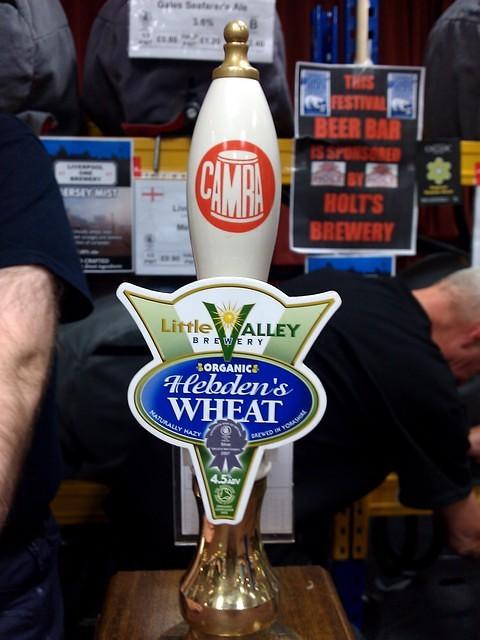
Yvan’s Champion Imperial Russian Stout of the 2011 NWAF
Outstanding “Matron’s Delight” (8%)
It was hard picking this one out, but after several repeat-samplings of my favourite imperial Russian stouts it took the cake. As far as I’m concerned this is my beer of the festival. Honourable mentions go to the Thornbridge “St. Petersburg” and the interesting Wapping “Superior Damson Stout”. These are all beers I’ll very happily buy again.
